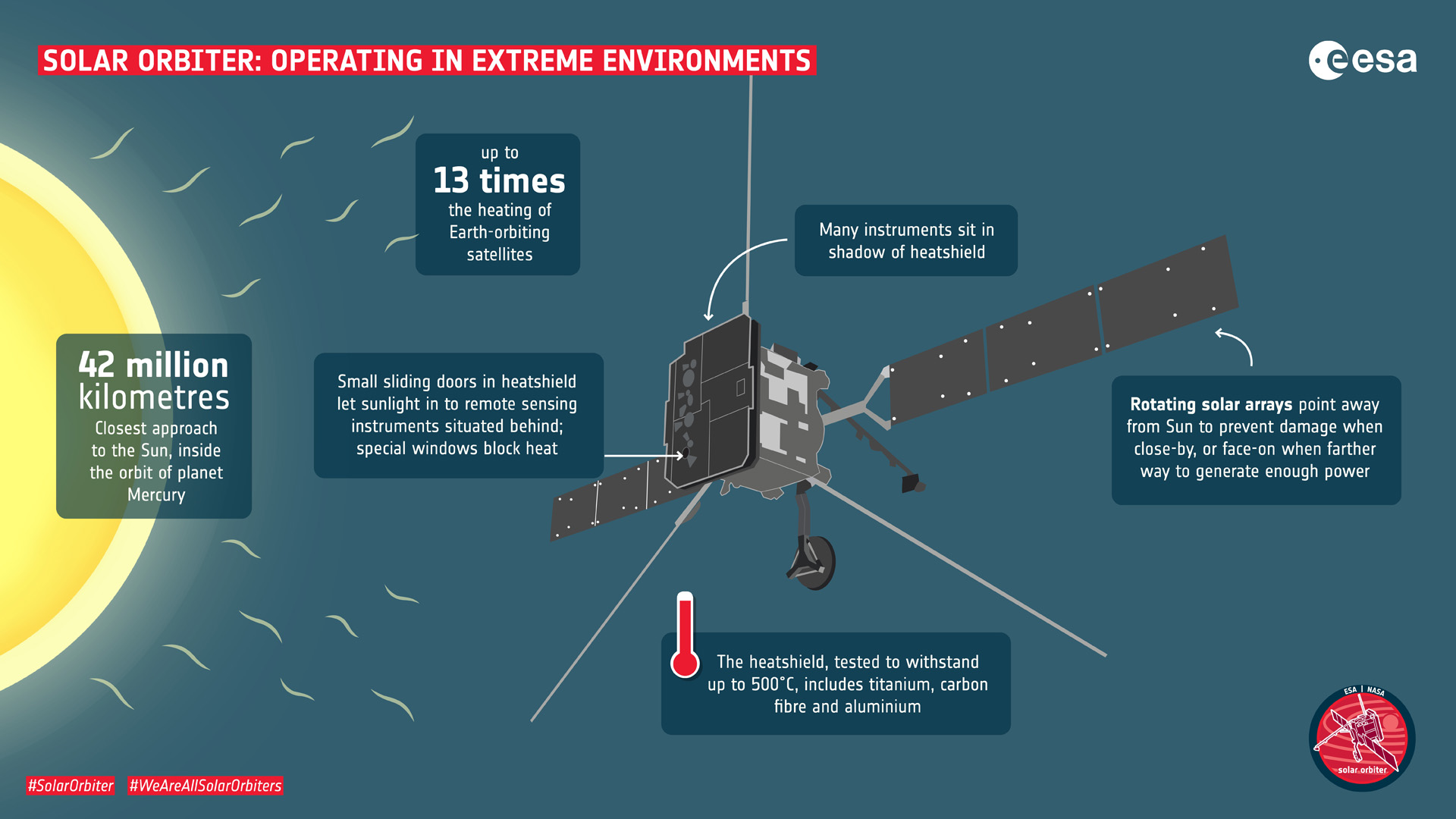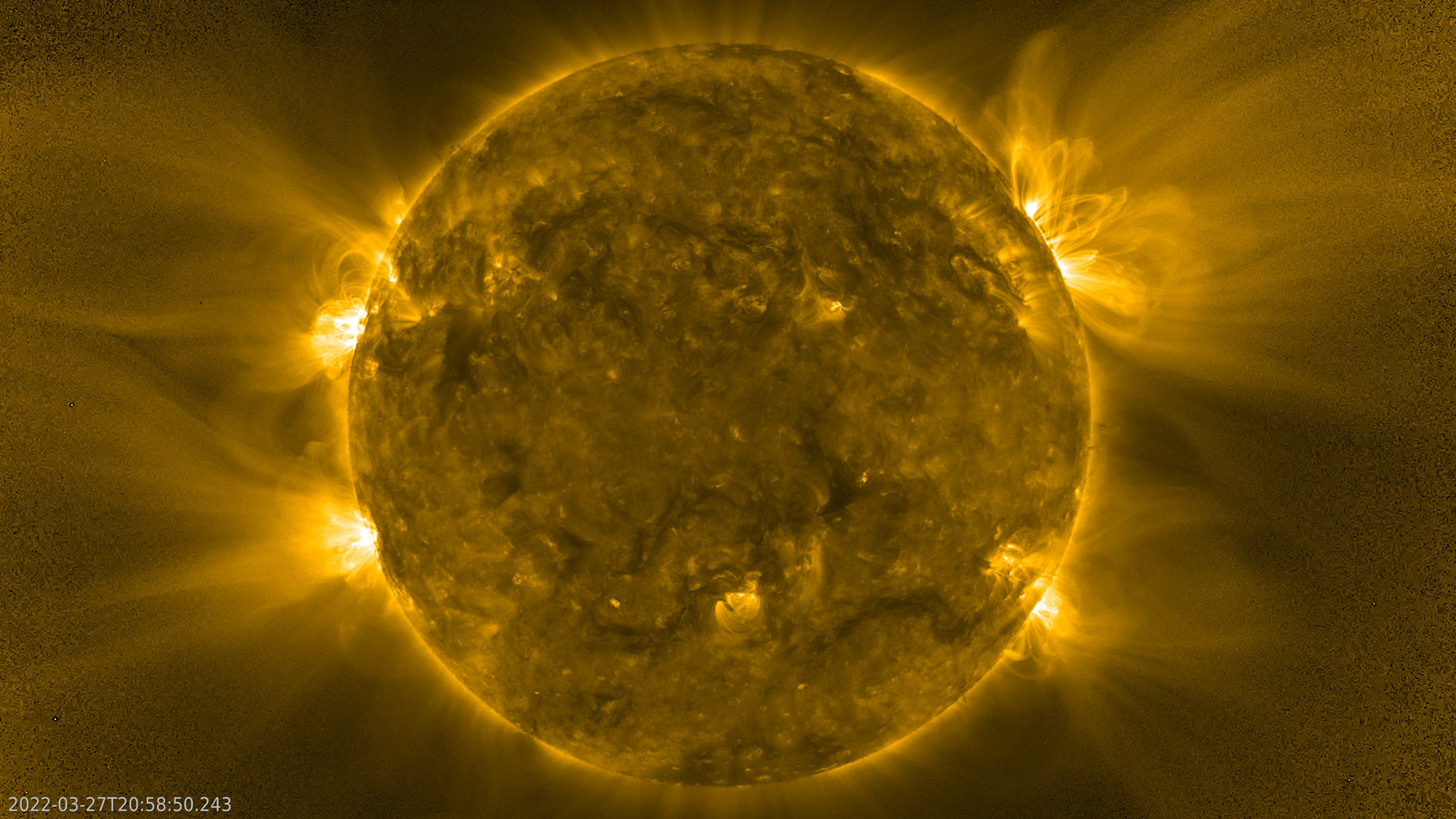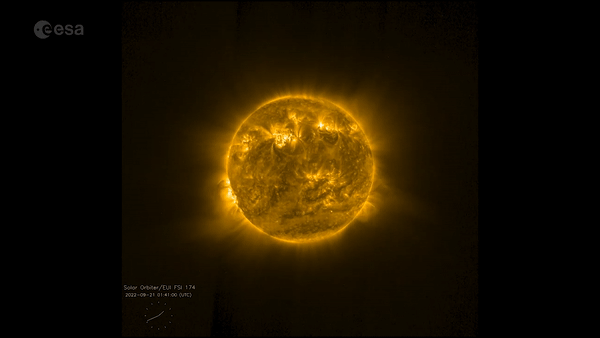Solar Orbiter: Seeing the sun like never before
Solar Orbiter works in tandem with NASA's Parker Solar Probe to explain the sun's mysterious behavior.

Solar Orbiter is the most complex scientific probe that's ever been sent to study the sun. Fitted with cutting-edge cameras and other sensors, Solar Orbiter takes the closest-ever images of the star at the center of the solar system. The Europe-led mission periodically approaches the sun's surface to less than a third of the sun-Earth distance. Only NASA's Parker Solar Probe makes closer dives to the star, but that spacecraft couldn't be equipped with sun-facing cameras due to the scorching heat it encounters.
The Solar Orbiter mission, launched on February 10, 2020, released its first images in June of that year. Although those images were obtained during the initial commissioning phase of testing the spacecraft and its instruments, scientists discovered in those images an entirely new type of solar phenomenon, miniature solar flares dubbed campfires.
Solar Orbiter entered its full science phase in March 2021 and has since been delivering a steady stream of awe-inspiring views of the sun. The spacecraft, fitted with a suite of 10 instruments, follows an elliptical orbit around the sun with the closest point, the perihelion, at about 25 million miles (40 million kilometers) from the star, which is closer than the orbit of the solar system's innermost planet, Mercury. During those close approaches, the spacecraft is exposed to temperatures of over 1,290 degrees Fahrenheit (700 degrees Celsius). European engineers had to develop many new technical solutions to make the spacecraft sturdy enough to survive in that intense heat and do its job.
Related: What color is the sun?
The mission is scheduled to last until at least 2027 but might get extended into the early 2030s. During its mission, Solar Orbiter will raise its orbit beyond the ecliptic plane in which the planets reside in order to view the sun's poles in detail for the first time in history. The sun's poles play a crucial role in the process that drives the generation of the sun's magnetic field, which in turn drives the 11-year cycle of solar activity, the ebb and flow in the generation of sunspots and eruptions.
The spacecraft
The Solar Orbiter spacecraft was built by a European consortium led by the aerospace giant Airbus. The sun-facing side of the satellite is protected with a 15-inch (40 centimeters) heat shield made of layers of titanium insulation attached to a honeycomb structure. Some of Solar Orbiter's 10 instruments peep through narrow windows in this shield, which open only during observation periods, in order to minimize heating.
The heat shield is coated with a layer of black pigment made of crushed burnt cow bones. Interestingly, despite being black, the coating helps to keep the surface of the shield at a manageable temperature of only 970 degrees F (520 degrees C) by effectively radiating some of the heat away.
Breaking space news, the latest updates on rocket launches, skywatching events and more!
The spacecraft carries six remote-sensing instruments, which are various types of imagers that look at the sun's surface in different wavelengths, and four in-situ instruments that measure the properties of the environment around the Solar Orbiter. The goal is to connect the phenomena observed on the star's surface with what is happening around the spacecraft, such as measuring the properties of the particles ejected from the sun in the form of solar wind in visible eruptions.
The remote-sensing instruments gave designers the biggest headache, as they need to face the sun directly yet also need to keep cool. In addition to the heat shield, engineers had to design all sorts of solutions to keep the temperature inside the spacecraft cold enough to make it possible for these instruments to do their jobs properly. Since there is no atmosphere in space and nothing to conduct heat, parts of the spacecraft hidden from the sun are exposed to freezing cold of minus 328 degrees F (minus 200 degrees C). Some of the heat that gets in through the heat shield can therefore be channeled away from the spacecraft's interior by radiators.
Solar Orbiter's two 20-foot-long (6 meters) solar arrays tilt with the distance from the sun in order to keep their temperature below 570 degrees F (300 degrees C). At higher temperatures, the panels could start falling apart. The tilting is controlled autonomously by a smart piece of software as Solar Orbiter spends regular three-month periods out of touch with Earth when on the opposite side of the sun from our planet. The ability of the solar panels to survive in the extreme environment will likely limit the mission duration, according to the European Space Agency.
The mission
Solar Orbiter travels around the sun on an elliptical path, completing one lap every five to six months. Its first perihelion in June 2020, the one that spawned the discovery of the campfires, was quite a bit farther away than the closest approaches the spacecraft is designed to make: 48 million miles (77 million km) away from the sun, which is about a half of the sun-Earth distance.
With every subsequent orbit, spacecraft controllers have tightened Solar Orbiter's trajectory around the sun to move the perihelion closer to the star. Instead of using onboard fuel, they did that using the gravity of Earth and Venus. In March 2022, Solar Orbiter's nominal science phase officially began when it made its first "proper" close approach at 30 million miles (48.3 million km) from the sun.
Solar Orbiter spacecraft controllers will continue taking advantage of the probe's regular visits to Venus to gradually shift its orbit out of the ecliptic plane in which the planets reside. A Venus flyby in February 2025 will nudge Solar Orbiter's path 17 degrees out of the ecliptic plane, allowing the probe to take the first views of the sun's poles a month later. By the end of the nominal science mission, Solar Orbiter's orbit will be inclined 24 degrees toward the ecliptic plane. But scientists hope to further increase this tilt to up to 33 degrees during the extended mission.
Main science questions
Although humankind has been eyeing the sun with curiosity ever since it became conscious of its own existence, there is still a lot we don't know about the star that makes life on planet Earth possible.
Space probes have observed the sun from Earth's orbit, and some even ventured farther out to take a closer look, such as the Europe-led Ulysses mission in the 1990s. But until recently, it was difficult to get close to the sun, as the technology required to withstand the heat was not yet ready.
As a result, there are still many unanswered questions about the sun's behavior, which increasingly affects our technology-dependent way of life on Earth. Space weather, which is caused by the interactions of the solar wind with Earth's magnetic field and its upper atmosphere, can knock satellites from orbit, disrupt GPS and radio links and disable power grids. Solar Orbiter's mission will help scientists make major leaps in our understanding of processes inside the sun and their effects on the entire solar system.
Here are the top science questions Solar Orbiter hopes to answer.
What drives the solar cycle?
Scientists still don't know what drives the generation of the sun's magnetic field and its fluctuations, which we can see reflected in the number of sunspots — cooler areas on the sun's surface that spawn eruptions and solar flares.
"We know that the magnetic field is responsible for all the activity that the sun produces, but we don't know how the magnetic field is produced," Sami Solanki, the director of the Max Planck Institute for Solar System Research in Göttingen, Germany, and principal investigator of Solar Orbiter's Polarimetric and Helioseismic Imager (PHI), said in an ESA statement. "We think it's a dynamo inside the sun that is doing it, similar to the dynamo that produces Earth's magnetic field, but we really don't know how the sun's dynamo functions."
The sun's magnetic field drives the 11-year solar cycle of activity, the ebb and flow in the number of sunspots and eruptions. The poles of the sun's magnetic field periodically switch every 11 years, but why exactly that happens is another mystery. Also, solar cycles vary in intensity from one to another, which scientists also can't explain.
What's going on at the poles?
Solar Orbiter began studying the sun just as the current solar cycle picked up intensity. Scientists hope the spacecraft's 10 instruments will be able to track changes on, above, and underneath the star's surface as the cycle approaches its peak, and provide clues to understanding the magnetic field. The ability to see the sun's poles in detail will play a key role in this endeavor. Computer models suggest that magnetized plasma flows through the sun's interior following regular patterns. The plasma periodically emerges from within at the poles only to disappear back into the star's depths shortly thereafter. Somehow, this process is connected to the quirks of the magnetic field.
"The sun’s poles are terra incognita," Solanki said. "It’s like the Earth 150 years ago. Nobody had been on the poles, so there will be a lot of new things to learn.”
Why is the sun's corona so hot?
Scientists are also puzzled by the extreme heat of the sun's outer atmosphere, the corona. At more than 1.8 million degrees F (1 million degrees C), the tenuous gas of the corona is much hotter than the sun's surface, which doesn't make intuitive sense as the corona is farther away from the source of the heat in the star's core. Scientists think that the peculiar magnetic field may have something to do with this unexplained heating.
"When we look how much energy is in the magnetic field, and how much energy is in the particles [of the corona], we see there's about 100 times more energy in the magnetic field," Säm Krucker, of FHNW University of Applied Sciences and Arts Northwestern Switzerland, and principal investigator of Solar Orbiter’s X-Ray Spectrometer/Telescope (STIX) instrument, said in the ESA statement. "If we release a little bit of magnetic energy, that means we can heat a lot of the particles, so that's what we try to understand."
In fact, the campfires discovered in Solar Orbiter's very first images may explain how this energy transfer happens. That such miniature solar flares may be an explanation for the mysterious coronal heating was proposed in the 1980s by NASA solar physicist Eugene Parker, after whom the Parker Solar Probe is named.
How does space weather spread throughout the solar system?
The stream of charged particles emanating constantly from the sun in the form of the solar wind and sometimes erupting in powerful bursts in the form of coronal mass ejections spreads throughout the entire solar system. Through this solar wind, the sun creates its zone of influence, the heliosphere, that stretches far beyond Neptune. To be inside of the heliosphere is good for us, as the sun's magnetic powers shield us from more harmful galactic cosmic radiation and powerful gamma rays.
Solar Orbiter, with its two sets of instruments connecting what's happening on the sun's surface with measurements of the properties of the magnetized solar wind in the spacecraft's vicinity, may provide important insights into how the sun maintains the heliosphere.
For example, scientists don't understand why solar wind particles travel at speeds of up to 800 kilometers per second (179,000 mph or 288,000 kph). The particles are ejected from the sun at much slower speeds but pick up momentum as they go.
"We are coming to realize that there are loads of variations in the speed of the wind, and huge variations in its magnetic field structure also," Tim Horbury, a solar scientist at Imperial College London, and the principal investigator of Solar Orbiter’s Magnetometer instrument, said in the ESA statement. "To my mind, the acceleration of the solar wind is the big question to answer. And I think we will do it, I really do."
Solar Orbiter discoveries
Since its launch in 2020, Solar Orbiter has made several revelatory observations and discoveries. In addition to spotting for the first time ever the miniature solar flares called campfires, Solar Orbiter also observed switchbacks in the solar wind, previously detected by NASA's Parker Solar Probe. These switchbacks — sudden S-shaped kinks in the coronal plasma — might be the reason for the unexplained solar wind acceleration. In these switchbacks, the direction of the magnetic field in the solar wind suddenly changes, which the Parker Solar Probe could measure but Solar Orbiter was able to actually see.
The probe has obtained a vast range of closer-than-ever images of the sun, including beautiful time-lapse sequences. It spotted odd behaviors of the solar plasma on the sun's surface, for which scientists have devised a range of funny names including the solar snake and the solar hedgehog.
Thanks to its regular visits to Venus, Solar Orbiter is also making contributions to the understanding of the odd magnetic field of this planet. Unlike Earth, Venus doesn't have an inherent magnetic field produced by the motion of liquid metal in its core. Venus' magnetism is a result of the interaction of the planet's thick atmosphere with the solar wind. During one of its flybys, Solar Orbiter discovered that this field, although extremely weak, extends at least 188,000 miles (300,000 km) from Venus away from the sun.
The mission has just started, so we can expect many more great discoveries from Solar Orbiter in the years to come.
Follow Tereza Pultarova on Twitter @TerezaPultarova. Follow us on Twitter @Spacedotcom and on Facebook.
Additional resources
To learn more about Solar Orbiter, check ESA's Science and Technology website or the mission's main page.
Bibliography
ESA, Secrets for Solar Orbiter to solve, September, 2020, https://www.esa.int/Science_Exploration/Space_Science/Solar_Orbiter/Secrets_for_Solar_Orbiter_to_solve
ESA, How to get the best view of the Sun, https://www.esa.int/Science_Exploration/Space_Science/Solar_Orbiter/How_to_get_the_best_view_of_the_Sun
ESA, Technical challenges of flying close to the Sun https://www.esa.int/Science_Exploration/Space_Science/Solar_Orbiter/Technical_challenges_of_flying_close_to_the_Sun
ESA, Why we need Solar Orbiter https://www.esa.int/Science_Exploration/Space_Science/Solar_Orbiter/Why_we_need_Solar_Orbiter

Tereza is a London-based science and technology journalist, aspiring fiction writer and amateur gymnast. She worked as a reporter at the Engineering and Technology magazine, freelanced for a range of publications including Live Science, Space.com, Professional Engineering, Via Satellite and Space News and served as a maternity cover science editor at the European Space Agency.




